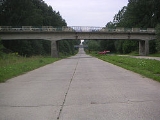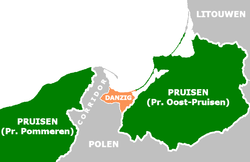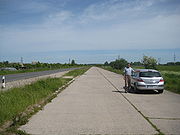
Berlinka
Encyclopedia

Polish language
Polish is a language of the Lechitic subgroup of West Slavic languages, used throughout Poland and by Polish minorities in other countries...
and Russian name given to sections of the unfinished Reichsautobahn Berlin-Königsberg, which was a pre-World War II German Reichsautobahn project to connect Berlin
Berlin
Berlin is the capital city of Germany and is one of the 16 states of Germany. With a population of 3.45 million people, Berlin is Germany's largest city. It is the second most populous city proper and the seventh most populous urban area in the European Union...
with Königsberg
Königsberg
Königsberg was the capital of East Prussia from the Late Middle Ages until 1945 as well as the northernmost and easternmost German city with 286,666 inhabitants . Due to the multicultural society in and around the city, there are several local names for it...
in East Prussia
East Prussia
East Prussia is the main part of the region of Prussia along the southeastern Baltic Coast from the 13th century to the end of World War II in May 1945. From 1772–1829 and 1878–1945, the Province of East Prussia was part of the German state of Prussia. The capital city was Königsberg.East Prussia...
. In the late 1930s, the sections near these two cities were finished, but not the larger section in between. The German demand in 1939 to run this road across the Polish Corridor
Polish Corridor
The Polish Corridor , also known as Danzig Corridor, Corridor to the Sea or Gdańsk Corridor, was a territory located in the region of Pomerelia , which provided the Second Republic of Poland with access to the Baltic Sea, thus dividing the bulk of Germany from the province of East...
with extraterritorial status and Poland's refusal to allow this was an important element in the tensions that led the start of World War II
World War II
World War II, or the Second World War , was a global conflict lasting from 1939 to 1945, involving most of the world's nations—including all of the great powers—eventually forming two opposing military alliances: the Allies and the Axis...
. After the war, the German Democratic Republic
German Democratic Republic
The German Democratic Republic , informally called East Germany by West Germany and other countries, was a socialist state established in 1949 in the Soviet zone of occupied Germany, including East Berlin of the Allied-occupied capital city...
, the People's Republic of Poland
People's Republic of Poland
The People's Republic of Poland was the official name of Poland from 1952 to 1990. Although the Soviet Union took control of the country immediately after the liberation from Nazi Germany in 1944, the name of the state was not changed until eight years later...
and the Soviet Union Kaliningrad Oblast
Kaliningrad Oblast
Kaliningrad Oblast is a federal subject of Russia situated on the Baltic coast. It has a population of The oblast forms the westernmost part of the Russian Federation, but it has no land connection to the rest of Russia. Since its creation it has been an exclave of the Russian SFSR and then the...
inherited the remnants.
Background


Treaty of Versailles
The Treaty of Versailles was one of the peace treaties at the end of World War I. It ended the state of war between Germany and the Allied Powers. It was signed on 28 June 1919, exactly five years after the assassination of Archduke Franz Ferdinand. The other Central Powers on the German side of...
by the Polish Corridor
Polish Corridor
The Polish Corridor , also known as Danzig Corridor, Corridor to the Sea or Gdańsk Corridor, was a territory located in the region of Pomerelia , which provided the Second Republic of Poland with access to the Baltic Sea, thus dividing the bulk of Germany from the province of East...
of the Second Polish Republic
Second Polish Republic
The Second Polish Republic, Second Commonwealth of Poland or interwar Poland refers to Poland between the two world wars; a period in Polish history in which Poland was restored as an independent state. Officially known as the Republic of Poland or the Commonwealth of Poland , the Polish state was...
. By 1939 Poland had already refused demands made by Nazi Germany, including one for an extraterritorial corridor within the Corridor. This fact was eventually used by Adolf Hitler
Adolf Hitler
Adolf Hitler was an Austrian-born German politician and the leader of the National Socialist German Workers Party , commonly referred to as the Nazi Party). He was Chancellor of Germany from 1933 to 1945, and head of state from 1934 to 1945...
as one of the pretexts for the German invasion of Poland in 1939.
The road was planned under the Weimar Republic
Weimar Republic
The Weimar Republic is the name given by historians to the parliamentary republic established in 1919 in Germany to replace the imperial form of government...
, but was partially constructed during the 1930s and early 1940s by the Third Reich.
Following territorial changes made after World War II
World War II
World War II, or the Second World War , was a global conflict lasting from 1939 to 1945, involving most of the world's nations—including all of the great powers—eventually forming two opposing military alliances: the Allies and the Axis...
it ran through three countries: the USSR (Kaliningrad Oblast
Kaliningrad Oblast
Kaliningrad Oblast is a federal subject of Russia situated on the Baltic coast. It has a population of The oblast forms the westernmost part of the Russian Federation, but it has no land connection to the rest of Russia. Since its creation it has been an exclave of the Russian SFSR and then the...
, modern Russia
Russia
Russia or , officially known as both Russia and the Russian Federation , is a country in northern Eurasia. It is a federal semi-presidential republic, comprising 83 federal subjects...
), Poland and East Germany. Its original purpose gone, some segments of the road were incorporated into local road networks while most of it fell into disrepair. The border between Kaliningrad Oblast and Poland was completely sealed to civilian traffic during the Cold War, given the high density of Soviet military installations in that area, which ensured the Berlinka section in that area saw almost no use. The border between Poland and East Germany was open to civilian traffic but the economies of the two countries were not well connected and auto traffic between them was not significant for many decades. Given these conditions, some segments of Berlinka became a minor tourist attraction in the years after the war, as an example of a Nazi-built autobahn preserved in an almost pristine state, carrying very little or no traffic. A number of movies made in Poland and the USSR that were set in Germany had their autobahn scenes shot on Berlinka sections. A popular Polish book and television series about Pan Samochodzik
Pan Samochodzik
Pan Samochodzik is a fictional art historian, journalist, renowned adventurer and historical detective created by Polish writer Zbigniew Nienacki. He is a main character in a series of adventures centering around historical mysteries and treasuers...
had a high speed car chase that was set on Berlinka (as at the time one of the few places in Poland where a high speed car chase was even plausible, given the execrable condition of other roads). In recent years that attraction has diminished as most of the stretches completed in the 1930s have been reconstructed to modern standards and largely lost their original appearance. Today the last remaining stretch that still has Nazi era construction features is signed as voivodeship road 142, north-east of Szczecin. As that stretch is only a local road, it is unlikely to be rebuilt in the foreseeable future.
Along with constructing the motorway, after invading Poland the Germans also quickly upgraded the main road going to East Prussia, in places paving it with concrete. Even though it is only a single carriageway road and not a motorway, it is also considered to be a part of Berlinka. This section includes one interesting cloverleaf interchange
Cloverleaf interchange
A cloverleaf interchange is a two-level interchange in which left turns, reverse direction in left-driving regions, are handled by ramp roads...
(54.04836°N 18.7610°E) and a large bridge over the Vistula
Vistula
The Vistula is the longest and the most important river in Poland, at 1,047 km in length. The watershed area of the Vistula is , of which lies within Poland ....
south of Tczew
Tczew
Tczew is a town on the Vistula River in Eastern Pomerania, Kociewie, northern Poland with 60,279 inhabitants . It is an important railway junction with a classification yard dating to the Prussian Eastern Railway...
(54.05205°N 18.81676°E).
Construction
Construction began in late 1933, using unemployed German workers as part of the state's reforms to counteract the Great DepressionGreat Depression
The Great Depression was a severe worldwide economic depression in the decade preceding World War II. The timing of the Great Depression varied across nations, but in most countries it started in about 1929 and lasted until the late 1930s or early 1940s...
- the construction of the Reichsautobahn (RAB) network. The first 113 km long segment near Stettin (now Szczecin
Szczecin
Szczecin , is the capital city of the West Pomeranian Voivodeship in Poland. It is the country's seventh-largest city and the largest seaport in Poland on the Baltic Sea. As of June 2009 the population was 406,427....
), Stettiner Dreieck to Stettin-Süd, was opened on September 27, 1936. The segment from Königsberg
Königsberg
Königsberg was the capital of East Prussia from the Late Middle Ages until 1945 as well as the northernmost and easternmost German city with 286,666 inhabitants . Due to the multicultural society in and around the city, there are several local names for it...
to Elbing (now Elbląg
Elblag
Elbląg is a city in northern Poland with 127,892 inhabitants . It is the capital of Elbląg County and has been assigned to the Warmian-Masurian Voivodeship since 1999. Before then it was the capital of Elbląg Voivodeship and a county seat in Gdańsk Voivodeship...
) was opened in 1937. In 1937, beltways near Stettin and Elbing were built.
In 1938 work slowed as Germany geared up for war
World War II
World War II, or the Second World War , was a global conflict lasting from 1939 to 1945, involving most of the world's nations—including all of the great powers—eventually forming two opposing military alliances: the Allies and the Axis...
and workers were directed to other projects. The highway featured prominently in Nazi political rhetoric of 1939, as Hitler
Adolf Hitler
Adolf Hitler was an Austrian-born German politician and the leader of the National Socialist German Workers Party , commonly referred to as the Nazi Party). He was Chancellor of Germany from 1933 to 1945, and head of state from 1934 to 1945...
's demands included an extraterritorial corridor - the Danzig Corridor through the Polish Corridor
Polish Corridor
The Polish Corridor , also known as Danzig Corridor, Corridor to the Sea or Gdańsk Corridor, was a territory located in the region of Pomerelia , which provided the Second Republic of Poland with access to the Baltic Sea, thus dividing the bulk of Germany from the province of East...
- which would connect Germany
Germany
Germany , officially the Federal Republic of Germany , is a federal parliamentary republic in Europe. The country consists of 16 states while the capital and largest city is Berlin. Germany covers an area of 357,021 km2 and has a largely temperate seasonal climate...
to Eastern Prussia. This, alongside other demands, was refused by the Polish government, and Hitler used this as one of the pretexts for the invasion of Poland in September 1939.
By October 1939 Poland was defeated
Invasion of Poland (1939)
The Invasion of Poland, also known as the September Campaign or 1939 Defensive War in Poland and the Poland Campaign in Germany, was an invasion of Poland by Germany, the Soviet Union, and a small Slovak contingent that marked the start of World War II in Europe...
, and work on the Berlinka resumed. The labor pool was increasingly composed of conscript workers
Unfree labour
Unfree labour includes all forms of slavery as well as all other related institutions .-Payment for unfree labour:If payment occurs, it may be in one or more of the following forms:...
from Poland. The Bäderstraße (near Rzęśnica and the Wielgowo) — Stargard-Massow (near Łęczyca
Łęczyca, West Pomeranian Voivodeship
Łęczyca is a village in the administrative district of Gmina Stara Dąbrowa, within Stargard County, West Pomeranian Voivodeship, in north-western Poland. It lies approximately west of Stara Dąbrowa, north of Stargard Szczeciński, and east of the regional capital Szczecin.Before 1945 the area...
) segment was built subsequently. Construction stopped in 1942 as military priorities once again took over available labor. In 1945 German forces, retreating along the Eastern Front, blew up most of the bridges to slow the Soviet advance.
Aftermath

Territorial changes of Poland
Poland is a country in Central Europe bordered by Germany to the west; the Czech Republic and Slovakia to the south; Ukraine, Belarus and Lithuania to the east; and the Baltic Sea and Kaliningrad Oblast, a Russian exclave, to the north...
and Germany
Territorial changes of Germany
The territorial changes of Germany refer to the changes in the borders and territory of Germany from its formation in 1871 to the present. Modern Germany was formed in 1871 when Otto von Bismarck unified most of the German-speaking states into the German Empire...
following the war, the road was divided and lost its importance as a route between German cities (most of Prussia's German population was expelled to Germany). The part that remained within German borders became the Bundesautobahn 11
Bundesautobahn 11
is an autobahn in eastern Germany that was opened in 1936. As it is partly in a dilapidated state, it is currently undergoing modernisation works on various stretches...
.
Certain segments of the route were nonetheless restored. In the People's Republic of Poland
People's Republic of Poland
The People's Republic of Poland was the official name of Poland from 1952 to 1990. Although the Soviet Union took control of the country immediately after the liberation from Nazi Germany in 1944, the name of the state was not changed until eight years later...
bridges over the Oder River near Szczecin were restored soon after the war, as were the bridges on the Banówka River near the border with the Kaliningrad Oblast. In the 1970s the planned part of the highway from Stargard-Massow (near Łęczyca) to Stargard-Freienwalde (near Lisowo
Lisowo, Stargard County
Lisowo is a village in the administrative district of Gmina Chociwel, within Stargard County, West Pomeranian Voivodeship, in north-western Poland. It lies approximately south-west of Chociwel, north-east of Stargard Szczeciński, and east of the regional capital Szczecin.Before 1945 the area...
and Chociwel
Chociwel
Chociwel is a town in Poland, in West Pomeranian Voivodeship, in Stargard County. It has 3,279 inhabitants .Prior to World War II Chociwel was in Germany and known as Freienwalde. It had a population of 3,406 in 1939. After the death and dislocation associated with the war, its population was...
) was finished, and bridges on the Ina River
Ina River
The Ina is a river in northwestern Poland, a right tributary of the Oder River.The origins of the river are in Insko Lake , and it flows through a succession of smaller lakes. A confluence of Ina River is localized in Police, Poland town...
restored.
With the end of the Cold War
Cold War
The Cold War was the continuing state from roughly 1946 to 1991 of political conflict, military tension, proxy wars, and economic competition between the Communist World—primarily the Soviet Union and its satellite states and allies—and the powers of the Western world, primarily the United States...
, and particularly with Poland joining the European Union
European Union
The European Union is an economic and political union of 27 independent member states which are located primarily in Europe. The EU traces its origins from the European Coal and Steel Community and the European Economic Community , formed by six countries in 1958...
, increasing thought has been given to reconstructing the road as part of the European highway system. In the 1990s a 14km long segment near the western Polish border was incorporated into the new A6 Autostrada (highway)
Autostrada A6 (Poland)
The autostrada A6 in Poland is a short motorway that starts at the Polish/German border at Kołbaskowo/Pomellen , forms a southern bypass of the Szczecin metropolitan area, and terminates to the east of that city where it becomes the S3 express road to Świnoujście...
. A further 7 km, to the junction with National Road 10, was being restored and was scheduled to open for traffic in August 2007. An additional 8 km is to be upgraded at some future date and redesignated as A6. In addition to the highway, Berlinka is incorporated into Polish National Road 22, voivodeship road 142, and expressroad 6/3. In the Russian Kaliningrad Oblast, it is incorporated into road P516.
As the original road was designed over 80 years ago, it would make little sense today to run a modern motorway along the same route as factors affecting road design changed greatly. Currently the road in Poland which will serve most of the route along which Berlinka runs will be the S6 Expressway
Expressway S6 (Poland)
Expressway S6 or express road S6 is a major road in Poland which has been planned to run from the A6 autostrada at Goleniów in West Pomerania to Gdańsk parallel to the Baltic coast, forming the main connection between Gdańsk and Szczecin.At present, the only significant section of S6 that has been...
, which runs to the north of Berlinka, closer to the Baltic coast.

